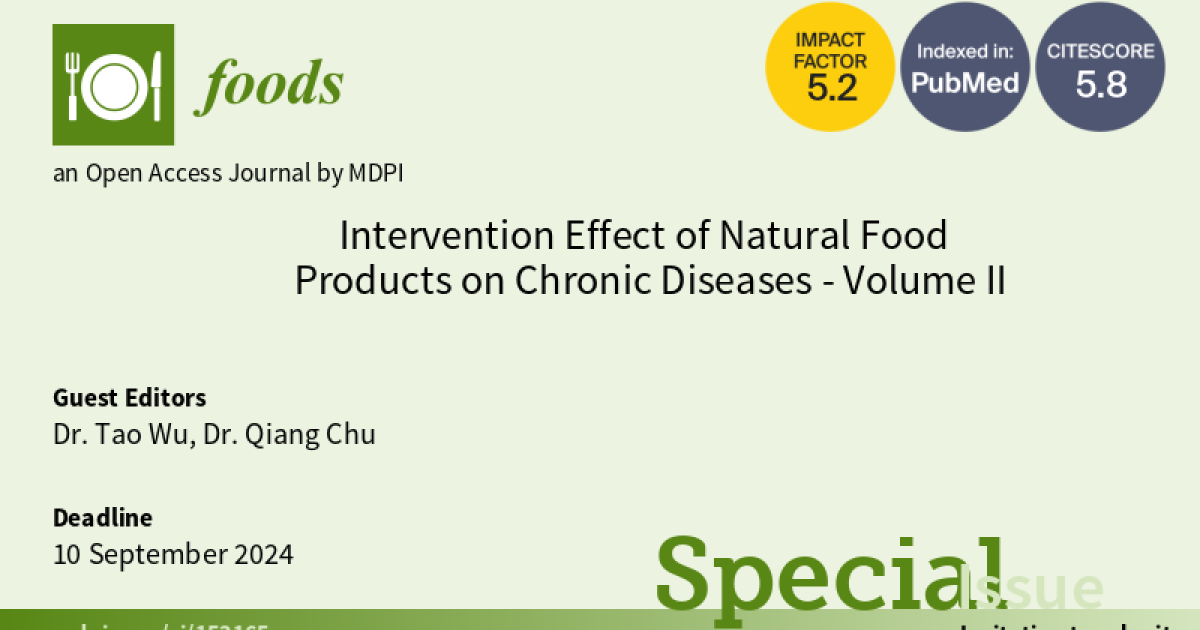Intervention Effect of Natural Food Products on Chronic Diseases - Volume II
A special issue of Foods (ISSN 2304-8158). This special issue belongs to the section "Food Nutrition".
Deadline for manuscript submissions: closed (10 September 2024) | Viewed by 15681

Special Issue Editors
Interests: food nutrition and function; natural products for chronic diseases prevention; development of new food resources
Special Issues, Collections and Topics in MDPI journals
Interests: nature products; lipid metabolism; glycometabolism; inflammation
Special Issues, Collections and Topics in MDPI journals
Special Issue Information
Dear Colleagues,
Chronic diseases such as obesity, diabetes, and cardiovascular disease have threatened human health for a long time and remain daunting challenges. As consumer demand for preventing chronic diseases increases, natural food products are drawing special attention in global markets. With the growing interest in food intervention, research has been widely concerned with applying natural food products such as polyphenols, polysaccharides, peptides, and probiotics in chronic disease prevention, as well as investigating their mechanisms, and this will attract much more attention in the future.
Therefore, this Special Issue aims to present a collection of studies focused on the current advances in the ‘Intervention Effect of Natural Food Products on Chronic Diseases’. We kindly invite you to submit original review/research articles with novel ideas/concepts related to this topic. Research addressing compositional aspects, in vitro and in vivo investigations, and efficacy evaluation in intervention studies is particularly welcomed.
Dr. Tao Wu
Dr. Qiang Chu
Guest Editors
Manuscript Submission Information
Manuscripts should be submitted online at www.mdpi.com by registering and logging in to this website. Once you are registered, click here to go to the submission form. Manuscripts can be submitted until the deadline. All submissions that pass pre-check are peer-reviewed. Accepted papers will be published continuously in the journal (as soon as accepted) and will be listed together on the special issue website. Research articles, review articles as well as short communications are invited. For planned papers, a title and short abstract (about 100 words) can be sent to the Editorial Office for announcement on this website.
Submitted manuscripts should not have been published previously, nor be under consideration for publication elsewhere (except conference proceedings papers). All manuscripts are thoroughly refereed through a single-blind peer-review process. A guide for authors and other relevant information for submission of manuscripts is available on the Instructions for Authors page. Foods is an international peer-reviewed open access semimonthly journal published by MDPI.
Please visit the Instructions for Authors page before submitting a manuscript. The Article Processing Charge (APC) for publication in this open access journal is 2900 CHF (Swiss Francs). Submitted papers should be well formatted and use good English. Authors may use MDPI's English editing service prior to publication or during author revisions.
Keywords
- natural food products
- polyphenols
- polysaccharides
- peptides
- probiotics
- inflammation
- obesity
- diabetes
- hypertension
- chronic diseases
Benefits of Publishing in a Special Issue
- Ease of navigation: Grouping papers by topic helps scholars navigate broad scope journals more efficiently.
- Greater discoverability: Special Issues support the reach and impact of scientific research. Articles in Special Issues are more discoverable and cited more frequently.
- Expansion of research network: Special Issues facilitate connections among authors, fostering scientific collaborations.
- External promotion: Articles in Special Issues are often promoted through the journal's social media, increasing their visibility.
- e-Book format: Special Issues with more than 10 articles can be published as dedicated e-books, ensuring wide and rapid dissemination.
Further information on MDPI's Special Issue polices can be found here.







